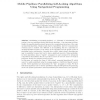Free Online Productivity Tools
i2Speak
i2Symbol
i2OCR
iTex2Img
iWeb2Print
iWeb2Shot
i2Type
iPdf2Split
iPdf2Merge
i2Bopomofo
i2Arabic
i2Style
i2Image
i2PDF
iLatex2Rtf
Sci2ools
HIPC
2005
Springer
2005
Springer
Mobile Pipelines: Parallelizing Left-Looking Algorithms Using Navigational Programming
Abstract. Parallelizing a sequential algorithm—i.e., manually or automatically converting it into an equivalent parallel distributed algorithm—is an important problem. Ideally, the parallel algorithm should preserve the computational structure of the original sequential algorithm, display a high degree of parallelism, have low communication overhead, and be scalable. The difficulty of accomplishing this for a particular sequential algorithm depends on the nature of the algorithm and the specific model of parallelism under consideration. Generally, the so called “right-looking” algorithms are easy to parallelize because they tend to have a significant amount of data parallelism. In these algorithms, data is “eagerly” propagated to and consumed by subsequent computations immediately after it is produced, and so it does not need to be kept in temporary storage for extended periods of time. In this paper we consider the class of “left-looking” sequential algorithms [1], w...
HIPC 2005 | Original Sequential Algorithm | Particular Sequential Algorithm | Sequential Algorithms |
| Added | 27 Jun 2010 |
| Updated | 27 Jun 2010 |
| Type | Conference |
| Year | 2005 |
| Where | HIPC |
| Authors | Lei Pan, Ming Kin Lai, Michael B. Dillencourt, Lubomir F. Bic |
Comments (0)

